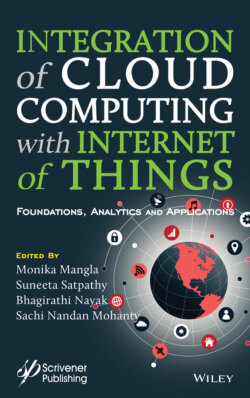Читать книгу Integration of Cloud Computing with Internet of Things - Группа авторов - Страница 18
1.3.2.1 IoT in Cloud Computing (CC)
ОглавлениеCC aims to deliver the hardware and software services across a parallel and distributed system. It has three important characteristics such as (a) virtual, (b) dynamic provision on-demand, and (c) negotiation. In this scheme, the hardware and software systems are interconnected dynamically and computerized virtually [19]. This way, the scheme reduces the carbon footprints and emissions besides decreasing the energy consumption appreciably. This can be achieved by transferring a few on-premises applications into the cloud. One of the real-life situations where CC finds its use is on-line marketing in which we procure goods and services without our presence in the shop-floor physically. Further, it reduces unnecessary expenditure on transportation and reduction in greenhouse gas emissions by each individual going to the shop-floor separately. As it is possible in CC to use the resources of the service provider rather than buying expensive equipment or systems for a business, it is economical. The reduction in the cost of using CC may be attributed to the following.
One can include new software, hardware, and system upgrade costs in his/her contract.
The expert data is found in the cloud, thus need to hire or pay the expert staff.
Thus, it reduces energy consumption.
Unnecessary time delays can be avoided.
Some of the other benefits that are offered by CC are security, flexibility, insight, quality control, increased collaboration, disaster recovery, competitive edge, loss prevention, sustainability, etc. The major advantages of CC have been shown in Figure 1.4.
The limitations of CC are briefed below.
Privacy agreement: The user in the CC platform requires the desired privacy and service level agreement before the commencement of the services. It delegates certain responsibilities on both the service provider and the user which needs to be adhered to by both the parties.
Security: The protection of data and the security against pilferage, theft, etc. need to be considered beforehand. While it is provided by the service provider in its periphery, the remote users need to weigh the security system before opting for CC.Figure 1.3 Softwarebased IoT applications.Figure 1.4 The benefits of CC.
Vulnerability: Since each component is easily accessible via the internet, it is likely to be attacked by hackers.
Limited flexibility and control: The uses in CC have limited control over the execution and function of the service provider as per the agreement signed by both parties.
Platform dependencies: The vendor lock-in or implicit dependency creates deep-rooted differences between the user and the service providers. This sometimes poses difficulties for users to migrate to other service providers at will due to additional cost, security, and privacy issues.
Cost: for small businesses or on a small scale, CC cost exceeds the cost due to staffing or hardware procurement.
Types of CC
The commonly employed CC services are briefed below.
Infrastructure as a service (IaS): In this, an external service provider facilitates the user with computer power and disc space via the internet. The users need to have hardware such as CPU, data storage, memory, or network connectivity. Examples of IaS are the Rackspace, Amazon EC2, Windows Azure, etc.
Software as a service (SaS): In this, the user can access the internet-hosted software by browsing. The service provider maintains and controls the software updates and the user has limited control over the configuration settings and the applications. It is mostly suitable for small businesses.
Platform as a service (PaS): It is a crossover between SaS and Ias. In this case, the user rents the operating system, hardware, network capacity, storage, etc. to the service provider. Thus, the user has the desired control over the computing setup, technical aspects, customization, etc. as per his/her need.
